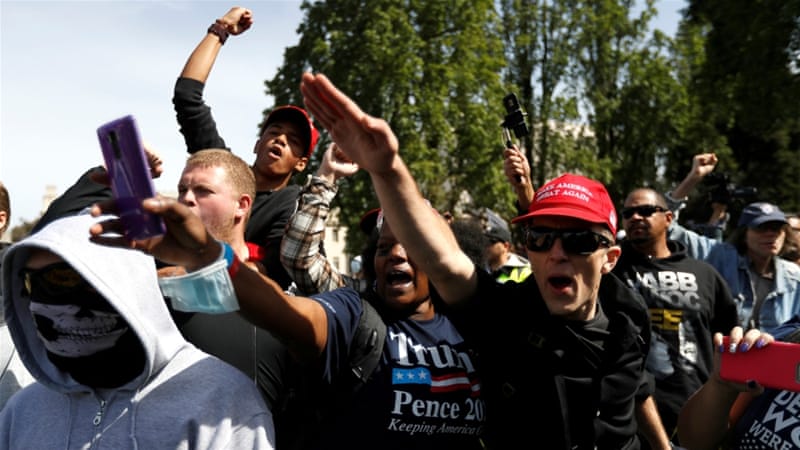White supremacists target Campuses
Group documents 330 bias incidents on US college and university campuses from late November 2016 to March…
Group documents 330 bias incidents on US college and university campuses from late November 2016 to March 2017.

When Tommy Curry woke up one day in May, he found a slew of death threats and hate mail on his voicemail and in his email inbox.
Although it wasn’t the first time Curry, an African-American philosophy professor at Texas A&M University, had received death threats, he was shocked by the “constant barrage” of messages threatening his life and those of his wife and children.
Curry says he received threats that said: “You and your family of African baboons might need to get killed” and “Crackers are coming to get your black ass.”
For weeks, he received these messages, often accompanied by images of monkeys with guns in their mouths or African Americans being lynched.
It all started after a seven-year-old podcast in which he discussed the history of slave rebellions and black self-defence against white supremacy in the United States, suddenly resurfaced on right-wing news sites and blogs.
“I said [in the podcast] that black people didn’t simply fantasise about killing their owners, and that we should understand the role that violence played in the liberation of black people,” recalls Curry, whose research focuses on modern black civil rights struggles and the history of black self-defence in the US.
Texas A&M, described Curry’s comments as “disturbing” and condemned racism, he has yet to issue a formal disavowal of the death threats targeting Curry and his family.
At the time of publication, Young had not replied to Al Jazeera’s request for a comment.
Curry argues that the death threats, as well as the university’s failure to sternly address them, highlight crucial issues of racism, free speech and academic freedom on campuses today.
Curry’s case is part of broader pattern of white supremacists targeting US campuses since the election of Donald Trump as president of the United States.
Surge in hate crimes
Between the November 8 election of Trump and April, the Southern Poverty Law Center (SPLC) watchdog documented 1,863 bias incidents, at least 330 of which took place on university campuses. In the 10 days following Trump’s election alone, the monitor recorded an average of 87 hate incidents per day. This is five times the daily average of hate crimes recorded by the FBI in 2015.
The SPLC noted that the initial increase in the number of bias incidents has since subsided, but it warned of the growing severity of recent incidents.
In May, Richard W Collins, an African-American Bowie State University student, was visiting the campus of the University of Maryland when he was stabbed to death by Sean Christopher Urbanski.
Authorities are now determining whether the murder was a hate crime owing to Urbanski’s involvement in a Facebook group titled the “Alt-Reich”, which refers to the German Third Reich and the alt-right. The page is chock-full of racist incitement directed at ethnic and religious minorities, primarily black Americans.
At Minnesota’s St Olaf College, at least two African-American students found notes on their property with racist language. One read: “Go back to Africa”.
Also in May, an incident at Washington, DC’s American University prompted the FBI involvement in an investigation into a hate crime that targeted the school’s first African-American, female student-government president.
On the morning she took office, Taylor Dumpson tells Al Jazeera she received messages from friends that bananas, tied with nooses, had been hung across the school grounds. The bananas were marked with “AKA FREE”, a reference to Alpha Kappa Alpha, a historically black sorority of which Dumpson was a member, and “HARAMBE BAIT”, which appears to refer to a gorilla that was killed at an Ohio zoo last year after a child had fallen into its enclosure.
“I immediately went into panic mode and shock,” Dumpson says. “Within a few hours, my parents were down at campus and … we were trying to prepare ourselves for what was being investigated as a hate crime.”
 |
| Bananas in nooses found on American University’s campus on May 1 [Courtesy of Quinn Dunlea] |
It was just a few days later that she became the victim of a second attack. In the midst of taking on her new leadership role and addressing the racist incident that was directed towards her, Dumpson noticed unusual activity on her Facebook page. Statements such as “that’s a good comment for a black girl” or what Dumpson describes as other “insensitive comments” started to appear on a number of her posts.
While Dumpson, who was still trying to digest what had taken place on campus, didn’t think much of the comments, she received an email from the Anti-Defamation League saying that a well-known white supremacist had called for people to troll her, linking to her personal Facebook page.
“That’s when it finally hit me that I was a victim of a hate crime and it had been brought to that level,” she says.
Dumpson thinks her experience was nothing new for the university. At least two other similar incidents had taken place in the three years Dumpson had been a student at American University. She almost transferred from the school during her first year after a number of “virulent racist comments” that were left anonymously on a social media application had been geographically traced back to the area.
She also says that swastikas had been drawn on a dry erase board and sexist posters hung throughout the campus on International Women’s Day.
Unlike these previous cases, however, hers was the only one that the university had taken steps to investigate as a hate crime, she adds.
In an email statement to Al Jazeera, American University said the investigation into the incident was ongoing.
In an update on its website at the end of May, the university said the FBI, as well as the city’s US Attorney’s Office and police department, continue to be “partners” in the investigation.
On the day of the incident involving Dumpson, the university’s president, Neil Kerwin, “strongly condemned” what he called the “crude and racially insensitive act of bigotry”.
 |
| Dumpson said at least two other banana-related incidents had taken place while she was a student at American University [Susan Walsh/AP Photo] |
Dumpson welcomed the university’s response, but says it was “unfortunate that it took something to rise to this level … and for an act against the student government president for a university to get its act together”.
She further explains that given the “current climate in the US”, it is the responsibility of the university and community to prevent such attacks from happening again.
“Specifically, as a result of the 2016 election cycle, people have become more comfortable,” Dumpson says, referring to Trump’s election.
“I think the most threatening part is that we’re beginning to see this rise up again because people feel comfortable and they feel empowered to have these kinds of beliefs, and that’s terrifying.”
White supremacists recruit
Such incidents come at a time of increasing white supremacist campaigns at American universities and colleges. Since the start of the 2016 academic school year, the SPLC has documented more than 135 incidents of white supremacist and white nationalist recruitment efforts on US campuses.
“It’s a definite uptick, and they’ve been making a concerted effort to flyer and paper as many campuses as they possibly can,” Lecia Brooks, the SPLC’s outreach director, tells Al Jazeera. She says the campaigning has notably increased since Trump won the election in November.
“It shouldn’t be hidden,” Brooks says, adding that the incidents have been documented at schools across the country. “The [university] administrations should always issue a strong statement of condemnation clearly stating who they [white supremacist groups] are and what they represent, encouraging students to disregard their recruitment [drives] and disavow their message.”
| [White supremacists] have been doing this for years because they think they have a chance and an opportunity to put their things in motion; and that’s only because Donald Trump is in office. |
In February, American Vanguard, a white supremacist group founded in 2016, announced on its website the “Texas Offensive”, a campaign of hanging flyers and posters on walls of a swath of campuses.
“This, of course, was met with a stream of vituperation and waves of publicity,” the group said in a statement on its website. “The lying press was working overtime to condemn us and get any official they could find to come out against the ‘white supremacists’.”
Other groups that strived to make inroads on campuses were Identity Evropa, a white nationalist alt-right group, and TheRightStuff, a blog that promotes Holocaust denial and other forms of anti-Semitism.
Identity Evropa leader Nathan Damigo, who recently gained national media attention for sucker-punching a female anti-fascist activist during a brawl in Berkeley, California, earlier this year described the campaigning as targeting “a false anti-white narrative” in academic settings.
‘Everything is heightened now’
Daryl Lamonte Jenkins, founder of the anti-racist organisation One People’s Project, argues that the surge in white supremacist activity and racist hate crimes has gained public attention “because everything is heightened right now.
“They’ve been doing this for years because they think they have a chance and an opportunity to put their things in motion; and that’s only because Donald Trump is in office,” he tells Al Jazeera.
Arguing that a clear majority of the American public rejects white supremacist movements’ vision and neo-Nazism, Lamonte adds: “Just because Trump won an election doesn’t mean they won the whole shebang. Communities are fighting against this.”
 |
| Since the start of the 2016 academic year, the SPLC has documented more than 135 incidents of white supremacist and white nationalist recruitment efforts on campuses [David J. Phillip/AP Photo] |
When white supremacist Richard Spencer gave a speech at Texas A&M University last year, protests erupted with anger at his presence on the campus. Spencer was invited by a private citizen who had rented the space for the event, but the protests later prompted the university to change its policy on who can speak on the school grounds.
Similar demonstrations took place over Spencer’s appearance at Alabama’s Auburn University in April.
Against the backdrop of growing violence, threats and protests, Michael Curry says his “horrible and traumatising experience” highlights the need to “recognise what’s happening in this country”.
“There are white supremacists who will come to kill people, and who have killed people, over the last several months for less than simply speaking about the issue,” he concludes, arguing that the recent rise in white supremacy is not detached from actual violence: “Murders have always been used to enforce racism.”
Source : Al Jazeera


